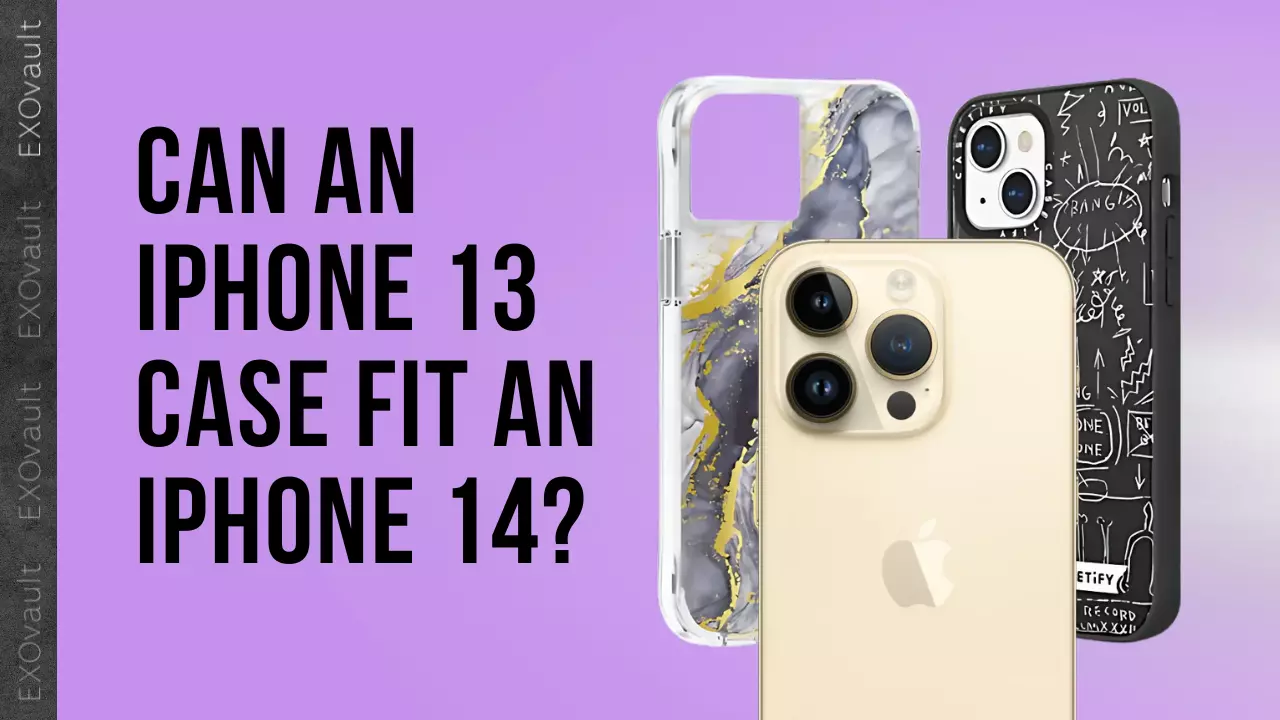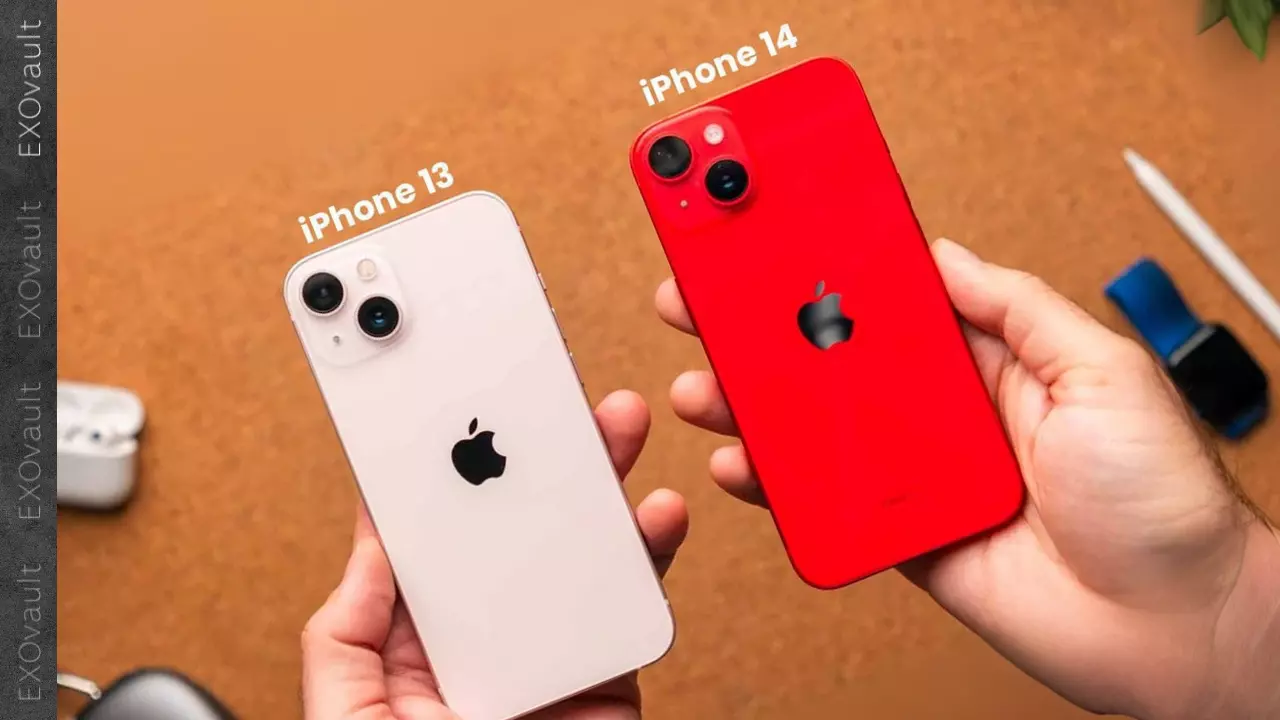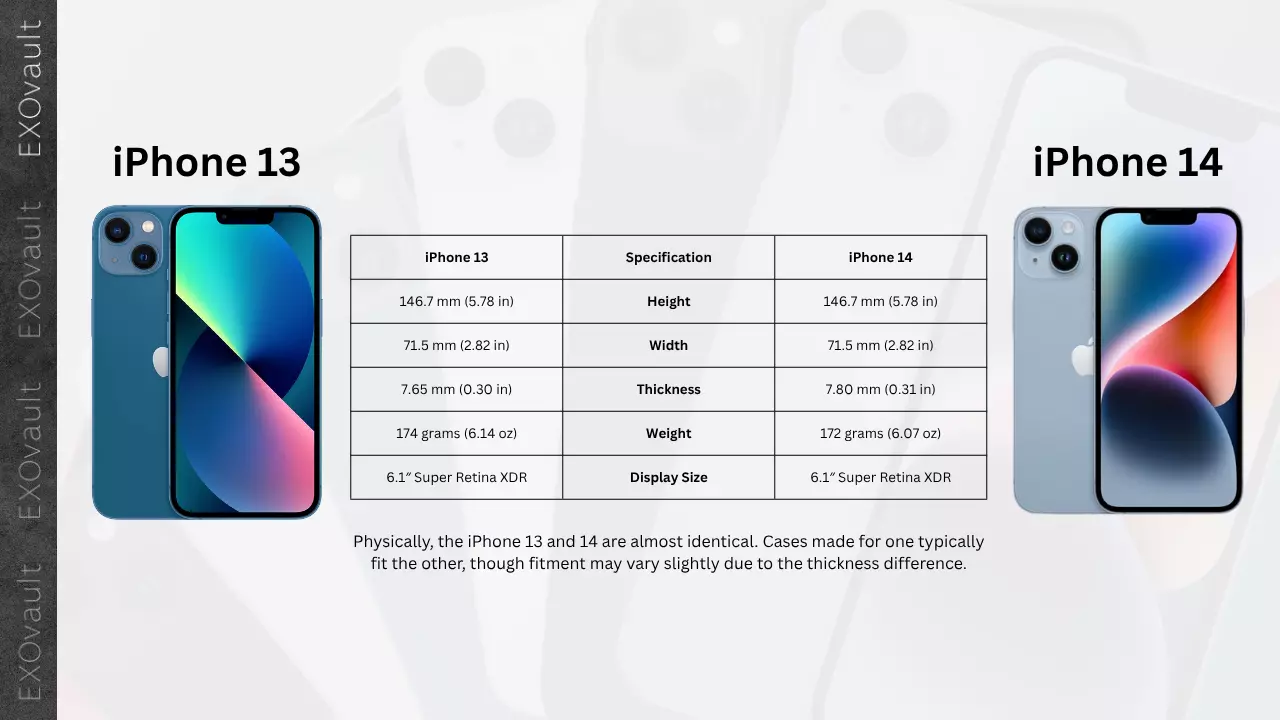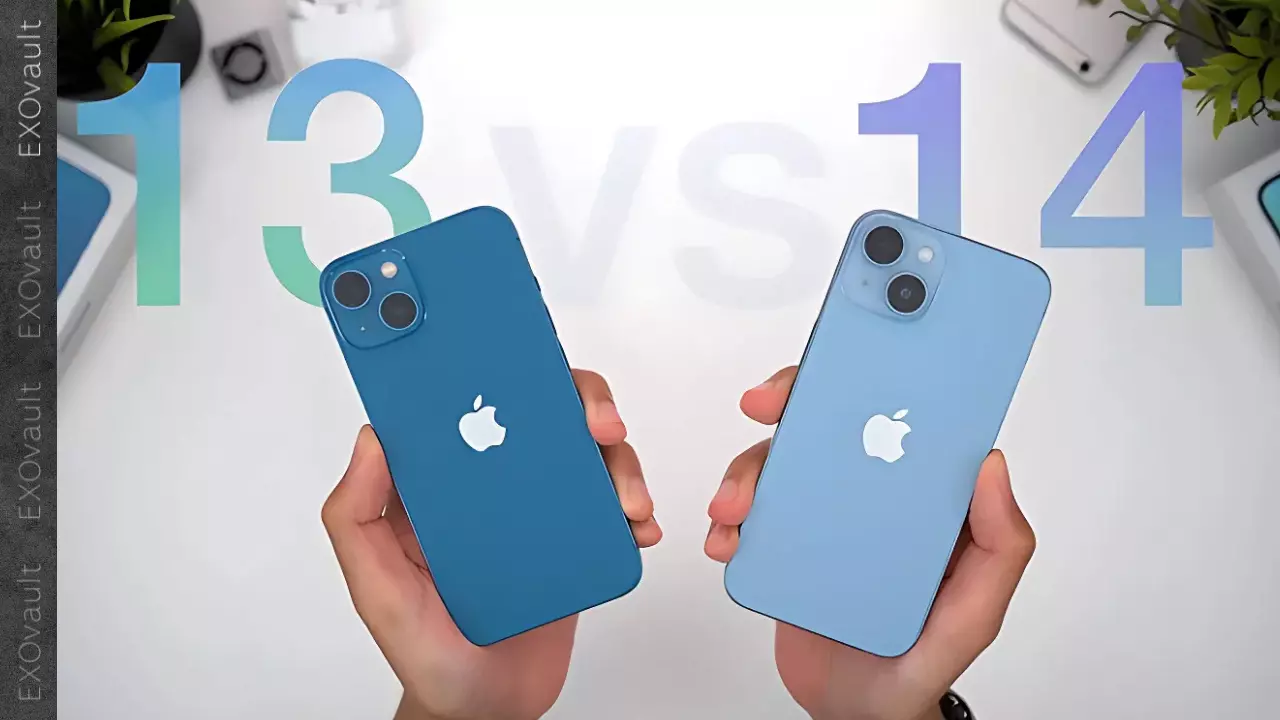Can an iPhone 13 Case Fit an iPhone 14?

Can an iPhone 13 case fit an iPhone 14? It’s one of the most common questions iPhone users ask, especially when they want to switch between recent iPhone models. At first glance, the two phones look nearly identical. The size, shape, and button layouts seem to be the same. However, even small differences in design can significantly impact the case fit. So, despite how similar the two models may look, can a single case work for both?
Usually, the desire to reuse a phone case stems from practicality, mainly the goal of saving money. iPhone cases, especially those made by premium brands, can be quite costly. Whether you're upgrading to the iPhone 14 or switching back to the iPhone 13, it’s natural to wonder if the old case can still do its job. However, when it comes to case compatibility, even small differences in size, camera placement, or button layout can affect the fit, so it’s worth taking a closer look before assuming it’ll work.
A case that doesn’t fit quite right might not seem like a big problem, but it can be. If the buttons are hard to press, the camera gets blocked, or the corners feel loose, it takes away from both the feel and function of your phone. At that point, the case isn’t doing its job. That’s why it’s not just about how a case looks; it needs to fit right to work right.

Why You Should Care About Case Compatibility?
Case compatibility matters more than one might think. iPhone cases aren't cheap, and a well-made premium case can cost $40. Many people also want to reuse or gift their existing accessories after upgrading or switching phones. Whether it’s about saving money, avoiding e-waste, or getting the most out of a favorite case design, knowing which case will work across models can help consumers make informed decisions.
Will iPhone 13 Cases Fit on iPhone 14?
At first glance, the iPhone 13 and iPhone 14 look nearly identical in size, both measuring 6.1 inches. The overall dimensions are very close, and even the button layout is quite similar. However, the rear camera bump on the iPhone 14 is slightly larger and positioned differently, which means most iPhone 13 cases won’t align perfectly with the camera cutout on the iPhone 14.
Because of this, using an iPhone 13 case on an iPhone 14 may result in poor fitment, covering part of the camera, or leaving gaps around the edges. It’s best to use a case specifically made for the iPhone 14 to ensure full protection and a proper fit.
Will iPhone 13 Pro Cases Fit on iPhone 14 Pro?
While both the iPhone 13 Pro and iPhone 14 Pro feature a 6.1-inch display size, the design differences between them are more than just the dimensions. The iPhone 14 Pro introduced the Dynamic Island, and its camera system is noticeably larger and raised more than the one on the 13 Pro.
This means that cases made for the iPhone 13 Pro will most likely not accommodate the iPhone 14 Pro’s bigger camera bump and adjusted button placement. Even slight misalignments can compromise usability, so it’s recommended to use a dedicated iPhone 14 Pro case.
Will iPhone 13 Pro Max Cases Fit on iPhone 14 Pro Max?
Both phones feature a 6.7-inch display, but like the other models, the iPhone 14 Pro Max comes with a larger camera module and a few structural tweaks compared to the iPhone 13 Pro Max. The button placements are slightly shifted, and the overall depth of the device is a bit different due to internal component changes.
Even though the size is nearly the same, the case fitment won’t be perfect, especially around the camera and side buttons. For that reason, cases made for the iPhone 13 Pro Max won’t offer the precision fit needed for the iPhone 14 Pro Max.
iPhone 13 Vs iPhone 14 Model-to-Model Comparison
| Feature | iPhone 13 vs iPhone 14 | iPhone 13 Pro vs iPhone 14 Pro | iPhone 13 Pro Max vs iPhone 14 Pro Max |
|---|---|---|---|
| Screen Size | 6.1" vs 6.1" | 6.1" vs 6.1" | 6.7" vs 6.7" |
| Dimensions (mm) | 146.7 x 71.5 x 7.65 vs 146.7 x 71.5 x 7.8 | 146.7 x 71.5 x 7.65 vs 147.5 x 71.5 x 7.85 | 160.8 x 78.1 x 7.65 vs 160.7 x 77.6 x 7.85 |
| Thickness (mm) | 7.65mm vs 7.8mm | 7.65mm vs 7.85mm | 7.65mm vs 7.85mm |
| Weight | 174g vs 172g | 204g vs 206g | 238g vs 240g |
| Button Placement | Slightly adjusted | Slightly shifted | Slightly shifted |
| Camera Module Size | Larger and raised on iPhone 14 | Much larger and higher on the 14 Pro | Larger and higher on 14 Pro Max |
| Case Compatibility | Partially compatible (some fit, not ideal) | Not compatible due to camera & button changes | Not compatible due to the camera & slight size shift |

Why an iPhone 14 Case Usually Doesn’t Fit Properly on an iPhone 13
At a glance, the iPhone 13 and iPhone 14 look almost the same, and for the most part, they are. The height, width, and screen size match up nearly perfectly. But when it comes to fitting a phone case, small design changes matter more than we expect. From camera bumps to button tweaks, here are the key reasons an iPhone 14 case usually won’t sit right on an iPhone 13.
1. The Camera Bump Isn’t the Same
One of the biggest design shifts is the camera module. The iPhone 14 has a slightly larger and more raised camera bump compared to the iPhone 13. And while this change might not seem major, it’s enough to throw off the case alignment.
If you try putting an iPhone 14 case on an iPhone 13, you may notice:
-
The camera cutout doesn't line up quite right.
-
Part of the lens or flash may get covered.
-
The case’s raised edges won’t properly surround the camera for protection.
Since the camera area is one of the most vulnerable parts of your phone, even a minor mismatch can affect both safety and photo quality.
2. Button Placement Is Just a Bit Off
The volume and power buttons are almost in the same spots between these two models, but not exactly. Apple shifted its position ever so slightly, and that small adjustment can mess with how well a case fits.
When the buttons don’t line up, you might run into:
-
Hard-to-press or unresponsive buttons
-
Edges of the case overlap the buttons.
-
Misaligned cutouts that just feel off
This might not seem like a big deal at first, but using buttons every day with added resistance or misalignment gets frustrating quickly.
3. It’s Just a Tiny Bit Thicker
The iPhone 14 is only 0.15mm thicker than the iPhone 1, which sounds like nothing. But for phone cases, especially those with rigid materials or precise MagSafe placement, even this tiny difference matters.
That extra fraction of a millimeter can cause:
-
Tight or forceful fitting
-
Pressure points that make the case bulge or pop off
-
MagSafe rings that don’t align properly weaken the magnetic hold.
Cases made from hard plastic or those with tight tolerances are the most affected here.

Are There Any Exceptions?
Sort of. If the case is made from soft, flexible materials like TPU or silicone, there’s a chance it might stretch enough to fit both models. But that flexibility usually comes with trade-offs.
What could go wrong?
-
The fit feels loose or sloppy.
-
Buttons become less responsive.
-
The camera area doesn’t sit flush, reducing drop protection.
-
MagSafe alignment may be off, making wireless charging less efficient.
So yes, a soft case might fit, but if you're picky about protection or aesthetics, it's far from ideal.
What’s the Best Solution?
If you want your phone to look good and stay protected, the best move is to use a case designed specifically for your model. A proper fit ensures:
-
Clean, responsive button access
-
Full edge-to-edge protection
-
Perfect camera cutouts with raised lips
-
Proper MagSafe or wireless charging alignment
Not only will the case look like it belongs, but it’ll function the way it’s supposed to, without annoying compromises.
Trusted Case Brands That Nail the Fit
Some brands design cases with super precise tolerances, ensuring that every cutout, button, and edge sits just where it should. Here are a few worth checking out:
-
Apple – Their official cases fit like a glove and support all features.
-
Spigen – Affordable, durable, and consistent with model-specific designs.
-
OtterBox – Great for heavy-duty protection and rugged use.
-
Caseology – Stylish with good all-around protection.
-
Nomad – Premium materials with a luxury feel.
-
Mous – High-end durability without bulk.
These brands test their cases against each specific iPhone model, so when you buy for the iPhone 13, you’re truly getting a case for the iPhone 13, not a one-size-fits-all guess.
Bonus
At EXOvault, we craft iPhone cases from premium metal and wood, combining durability with refined design. Each case is engineered for protection while showcasing the natural beauty of the materials we use.
Who Should Especially Care About This?
Upgraders & Swappers
If you’ve recently upgraded from an iPhone 13 to an iPhone 14 (or vice versa), you may want to reuse your case. While this seems sustainable and frugal, it’s likely to be a poor experience unless the case is ultra-flexible, and even then, you’ll sacrifice functionality.
Gift Givers
Buying a case as a gift? Make sure you know the exact model. Even a minor mismatch could lead to an unusable gift.
Eco-Conscious Buyers
Reusing accessories is environmentally friendly, but when protection is compromised, it’s best to either donate or recycle your old case and get one that fits properly.
Final Verdict
At first glance, the iPhone 13 and iPhone 14 look so alike that you might think their cases should be interchangeable. However, design details like camera bump size, button placement, and even device thickness matter when it comes to case compatibility.